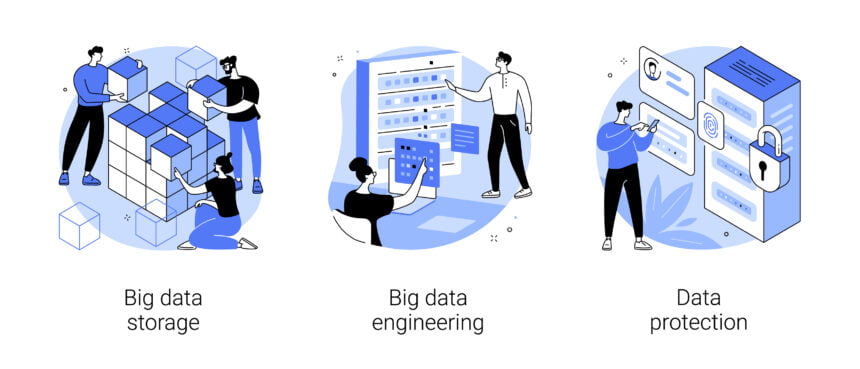Given the growing importance of big data and the rising reliance of businesses on big data analytics to carry out their day-to-day operations, it is safe to say that big data has irrevocably altered the online world for anyone running a digital enterprise or an e-business.
Big data’s invaluable insights are an essential factor in the success of enterprises. Predicting seasonal bestsellers and providing a foundation for improving the brand-consumer relationship are just two areas of business management made easier by the insights revealed by big data.
However, most business owners and security experts tend to ignore the ‘dark’ side of big data, despite the fact that many have integrated the insights generated by big data into the core of their operations and are harnessing its power to set themselves apart from competitors.
While “the dark side” of anything certainly has a sinister ring to it, the many risks and dangers linked with big data are often overlooked and treated as minor issues. The concerns related to big data surge to the top of the ‘security and privacy concerns’ hierarchy as the power wielded by these big-data insights continues to expand rapidly.
To help our readers understand the gravity of the many security risks associated with big data-generated insights, we’ve created an article that focuses on the most pressing privacy worries and offers strategies for addressing them.
1. Breaches That Result in Obstruction of Privacy
Many people worry about the state of their privacy, especially their online privacy, in today’s rapidly evolving digital ecosystem, where phenomena like the “filter bubble” and “tailored marketing” are on the rise. There seems to be a constant decline in online privacy.
Considering the current state of cybersecurity, our future may very well resemble something out of an Orwellian nightmare. When we consider the privacy breaches made possible by big data insights and analytics, the gravity of the situation becomes even clearer.
Security-focused businesses are many times ahead of the curve, therefore we should draw our cues from them. NordVPN, a supplier of VPNs, has a solid reputation in Canada, mostly due to the company’s commitment to keeping user information secure.
Contrary to popular belief that a VPN only helps with unblocking websites or changing your Netflix region to access a more diverse library of movies/TV shows, these tools help boost consumer anonymity and privacy by encrypting all traffic.
Realizing the relevance of privacy and the value that sensitive information carries, it is essential to the survival of a company that they establish measures that prevent the disruption of customer privacy because of the value that sensitive information holds.
2. Anonymity is Difficult to Acquire – It’s a Fugazi
The ability to remain anonymous online is still regarded as a superpower, used by people like undercover journalists and those who live in countries with tight restrictions on free speech, despite coming under intense scrutiny in recent years.
Big data analytics makes it hard for any firm to keep any data files completely anonymous. Due to the heterogeneous nature of the raw data sets upon which big data insights are built, there is a substantial risk that consumers’ identifying characteristics will be made public, destroying any remaining privacy they may have.
Even though data is intended to be fully “anonymized,” it is common practise for many security personnel to combine valuable files in order to quickly spot an user. Since almost every small or medium-sized internet business uses finance, invoicing, and accounting software hosted by third parties in the cloud — and since these providers often have different policies on user data — anonymization becomes even more difficult.
3. Failure of Data Masking in a Big Data Environment
Most businesses today employ a process called “Data masking” to shield sensitive information from prying eyes on the Internet. Data masking, also known as data obfuscation, is the practise of concealing sensitive information by means of a false front of seemingly innocuous text or numbers. Data masking is typically used to hide sensitive data from prying eyes.
Data masking could completely fail if not used correctly, jeopardizing the security and, consequently, anonymity of many people engaged in big data analytics. Companies often overlook the hazards associated with big data, which magnifies the threats to users’ privacy.
To solve the problem of how to make data masking work with big data, businesses must implement a strict policy that details the criteria for data masking and ensures that they are followed by all employees.
4. Big Data Insights Result in Discrimination
One would think that as humanity evolves and embraces the arrival of the digital age, racism and other forms of overt prejudice would be left in the dust, but alas, they remain pervasive problems with lasting consequences.
Despite the fact that prejudice occurs in virtually every industry, the incorporation of big data insights and analytics has made it possible for businesses to learn an individual’s race and use that knowledge to their advantage.
For instance, a bank may use predictive analytics to learn a loan applicant is a member of a particular racial group and then reject their application; this practice, known as “automated discrimination,” has gained widespread attention in recent years.
5. All Patents and Copyrights Become Null and Void
Another issue that makes the incorporation of big data into organizations pretty difficult is the fact that in an environment driven by big data, obtaining patents can be an extremely difficult task, and ultimately as a result, it gets completely ignored.
One of the main reasons why it’s so hard to get patents in today’s big data era is because it takes so long to validate the patent’s uniqueness among the accessible database of information, which is why it’s often shrugged off.
Furthermore, in a world where big data reigns supreme, copyrights are mostly irrelevant because of how easily data can be manipulated. Consequently, this leads to the disappearance of any royalties earned from the creation of something original.
Wrapping Up
We can only hope that by the end of the article, the reader understands the gravity of the “Big Data Situation” and the myriad privacy concerns that arise in a data-driven environment. We can only keep our fingers crossed that the aforementioned privacy problems are given the attention they deserve by institutions, and that measures are taken to address them.








